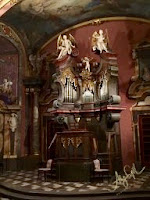In keeping with all the other dichotomies that make Prague such a wonderful place to live and work, the amount of green space in the city means you don't have to go far to find a peaceful park or garden to relax in and get out of the madness of the hubbub. According to the city tourist board, green space accounts for over 20% of the city area. Many of these places are obvious, like the Letná plateau hanging over the city like a backdrop in a theatre or
Vítkov hill. Others need to be sought out, like
Vojanuvy sady and the
Franciscan gardens.
Some of the best green places involve leaving the confines of the Old Town and heading a little further afield. I've written about
Vysehrad previously, but in this post, I wanted to write about the first park in Prague that I visited, almost four years ago to the day.
 |
| The view from the Pavilion (with my friend Elena) |
Having just moved to Prague, I wanted to find somewhere I could go running directly from my flat in Vinohrady, preferably somewhere that didn't involve too much pavement pounding. According to the map, there was a massive park just a couple of hundred yards from my flat, called Havlíčkovy sady (Havlicek Park). So, on my first newbie Sunday, I wandered off in the early chill of an October morning to investigate. There were a few dog walkers around, but the park was mostly empty apart from dozens of red squirrels hiding their stashes ready for the winter. This part of the park was wooded but with plenty of light breaking through the sparse canopy. The paths were wide and well maintained and it was a pleasant walk until suddenly the path appeared to go over a cliff!
 |
| From the grotto looking out on the park |
Havlíčkovy sady (also known as Grébovka) spans the neighbourhoods of Vinohrady, Vršovice and Nusle. It covers nearly thirty acres (11 ha) of which just over four acres (1.7 h) are vineyards. These vineyards date back to the thirteenth century and give their name to the nearby area now known as Vinohrady. Over the next six hundred years, the vineyards changed hands many times and were owned by Benedictine monks, Jesuits, as well as private landowners. In 1870 the land was acquired by the industrialist Moritz Gröbe who built the Villa Gröbe.


This was a monumental summer residence, designed in a neo-Renaissance style, and landscaped into an English style park. Other lavish and self-indulgent features were added for the entertainment of the family and their guests, including an artificial grotto, a casino with a shooting range, a bowling alley, and chess tables. Gröbe also restored the original vineyards and added an impressive gazebo – which is now protected as a monument. Gröbe’s heirs resented having to maintain the estate and they sold the house and land to the Vinohrady municipality, which opened the park to the public at the beginning of the 20th century, under the name “Havlíčkovy sady”.
The park features over 120 different species of domestic and foreign trees, and 25 species of bird, including 12 which nest in the park. The grotto was constructed by creating artificial rocks from bricks, mortar and cement to resemble stalactites. An observation deck was created and underneath, a fountain and pond, adorned with a statue of Neptune. During the 1970's the area became a shelter for the homeless, drug addicts and underage drinkers and fencing with barbed wire was erected. In 2010 the grotto underwent major reconstruction.
The vineyard still operates on a small commercial basis, producing about 4000 litres of wine each year. The old casino, bowling alley and parts of the pavilion are used for special events, and the gazebo is now a small cafe where you can drink the wine and look out over the vineyards where it originated. And a rather splendid little wine it is!
 |
| A splendid little wine! Na zdraví |
As for my running - I never did run in Havlíčkovy sady. Going down the steep slopes was one thing but going back up them again wasn't for me! In fact, it was another year before I ran in Prague for anything other than a tram!








